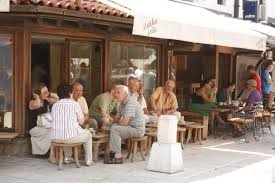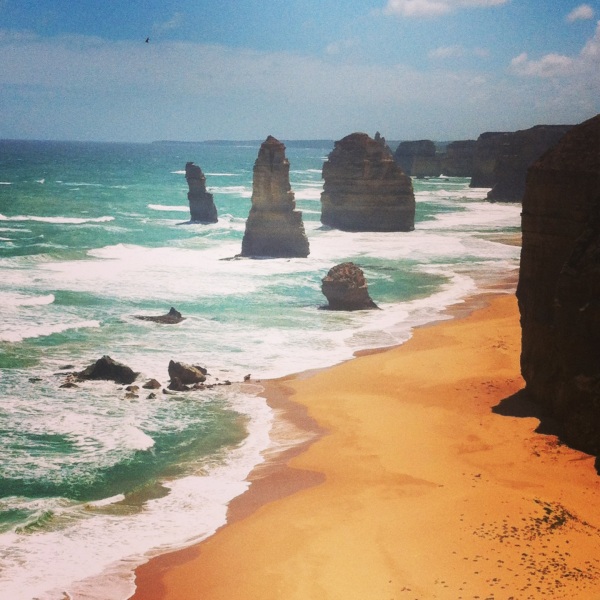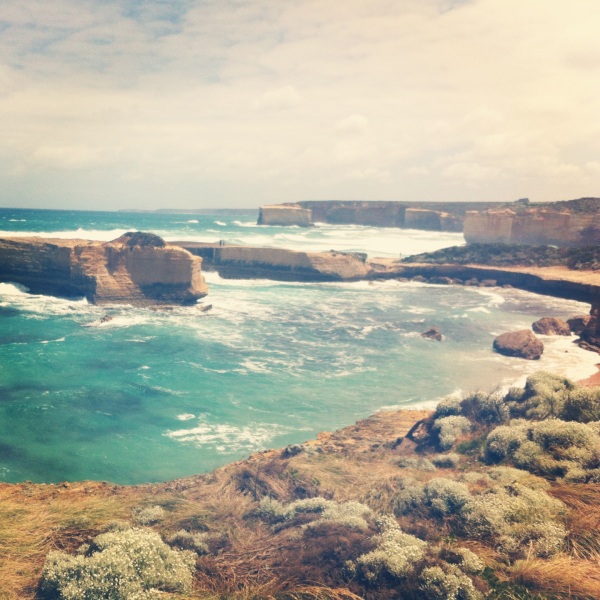Precariously perched at the edge of the world, New Zealand is bareley crammed into our country-centric worldview. As such, it is considered our antipode, and it’s inhabitants antipodeans. An antipode literally means “opposed, foot”, and in geography it is the place on the earth’s surface that is most diametrically opposed to another point on the earth’s surface. In the Northern Hemisphere many assume Middle Earth, ahem New Zealand to be their antipode. However, Spain is the North Island’s true antipode. In case you need reminding just how far away you are, there’s even a group of islands off the coast of New Zealand known as the Antipodes Islands. Despite being one of the last places in the world to be settled by humans, New Zealand was the first to grant women the right to vote, and also preserve its land as part of a national park. Its remoteness and small population have been its saving grace, and today both the North and South Island offer some of the world’s most unique and pristine landscapes. You’d be hard pressed to find a less than comely corner of this country, so whatever trail you set out to tramp, helicopter, bungee, paraglide, 4-wheel, or surf, expect it to be awe-inspiring.
As my plane descended into Auckland I was struck by the spectacular views outside my window. A narrow strip of land separated the turquoise-hued Tasman and Pacific, and just beyond their near convergence were countless undulating volcanic peaks. I quickly took out my camera to start snapping photos, only to be interrupted by the man beside me “First time to New Zealand?” I responded “yes” before he continued, “You’ll love it here. It’s the most beautiful country I’ve ever seen.” Well, I thought, I haven’t even landed in this country and already I have some rather lofty expectations.
I arrived in New Zealand by way of Indonesia, and met up with my parents and brother who flew in from Colorado and Montana. After a fuel leak on their end, and being re-routed through Hawaii and Fiji, we reassembled in Auckland, the airport offering the best range of international flights, and the most convenient place to being our North and South Island campervan tour. Before picking up our boxy camper (particularly considering New Zealands narrow roads and numerous one-lane bridges), we hopped on and off the Auckland explorer bus for an abbreviated city tour, and took in a Maori cultural show at the Auckland Museum. We all found ourselves remarking about the similarities between Auckland (and later Wellington) and the cities along America’s pacific coast, starting with San Francisco all the way up to Vancouver. Perhaps this could be attributed to the colonization in the wake of Captain Cook’s Pacific explorations, or simply the appeal of the Pacific. Later, when we went to pick up our RV, we bypassed countless rows of nondescript white campervans, only to be given the lots most prized campervan, the ”Crazy About Rugby” mobile. For whatever reason, the Maori gods were smiling on us and for the next two weeks we happily pledged our allegiance to the All Blacks (and in the process made a lot of kiwi friends).

”Crazy About Rugby”
Rotorura was our first stop south of Auckland, luring us with its hotbed of geothermal activity. Before we even reached the main street of town, there was a distinctive sulfur scent in the air. Some call Rotorura “Roto-Vegas” given its commercialized tourism, which in my opinion is a big stretch. If this was New Zealand’s version of Vegas, it only made the country that much more endearing. The main center for tourism in town is Te Puia, a Pacific inspired building offering tourists anything from hanji feasts, Maori performances, geyser tours, etc. One could idle hours away just in their gift shop, which we nearly did, but before long daylight was fading and we had yet to find our first campsite. After a few wrong turns up farming roads, we arrived near dusk at the Blue and Green Lakes campsite just Southeast of Rotorura. I rose early the following morning for a run along Blue Lake, just as the sun was stretching its way across the lake and through the trees. On my return trip, I plunged into the refreshing and aptly named blue lake, thereby initiating my baptism into the kiwi lifestyle.

Eager for more Volcanic activity, we pressed on towards the Tapuo volcanic zone, a tumultuous region spanning from Rotorura over to the Bay of Plenty. En route, we passed by New Zealand’s largest lake, Lake Taupo, which looks to be more like an ocean than a lake and sits in the middle of a volcanic caldera. Wrapping our way along the lake we marveled at the many modern lakefront properties, before starting the climb to Tongariro National Park. Tongariro National Park is New Zealand’s first national park, and the world’s fourth, and boasts three impressive mountains. Mt Rupaehu is the mountain that first sparked the climbing interest of one of New Zealand’s most beloved countrymen, Sir Edmund Hillary. Mount Ngauruhoe, which is better known as Mt. Doom from the Lord of the Rings. We chose to climb the third, Mt Tongariro, since it wasn’t as foreboding as Mt. Doom, and our fitness levels weren’t quite Sir Edmunds caliber. It’s recommended that you hike the Tongariro Alpine Crossing by starting at the lower parking lot, crossing over the top and then sleeping and walking back the next day or catching alternative transportation on the other side. Since we already had accommodation in our camper, we chose to hike to the top and then turn around, which ended up being a 12-mile hike. The higher you climb, the more picturesque the landscape becomes. The hike began in a vast, barren landscape on a well-maintained trail across a lava field, and then traversed up the spine of the mountains. The top was scrappy, but well worth the panoramic views. In one direction clouds hovered over Mt. Doom, to the west were three milky-blue pools and a caldera on the horizon. Once we reached the bottom we rewarded ourselves with a tasty, massive meal of lamb shanks at Schnapps pub in National Park Village.
The last stop we made on the North Island was its most southwestern point, New Zealand’s capital city of Wellington. I’m still trying to wrap my head around how unexpectedly awesome this city was. It may be small, but that didn’t stop it from packing a lot of punch, well deserving of its title “coolest little capital in the world.” We arrived in Wellington the day school finished for the semester, so the city was awash with academic relief, excitement and high spirits. Everyone was fashionably clad, and enjoying themselves with celebratory beers and wine along the waterfront. The warf area, which has recently undergone a series of renovations, is the real draw of the city. It is chock-a-block with fun bars and restaurants, museums, and public artwork (keep your head up as some of the coolest is floating overhead). Further down the waterfront is the colossal Te Papa museum. It is approximately the size of three football fields, with every square impeccably well curated. Highlights include an outside bush walk displaying New Zealand’s native flora and fauna, and inside an interactive house that shakes as though you are experiencing an earthquake. Make sure to also visit the exhibition on the Pacific and New Zealand history. The only drawback of life in ”Windy Welly” is the powerful wind that barrels through (it’s been known to tip over ships). If you’relooking for a scenic camping spot I’d recommend not sleeping at the downtown Holiday Park. We decided to stay in the city so we could catch the Cook Strait Ferry the following morning, and they ended up corralling us onto a big swatch of pavement jammed together with our closest camper friends. Nonetheless, I enjoyed walking around the city’s downtown in my pajamas alongside women in high heels and flouncy dresses.
Although the Cook Strait is known for its choppy waters and is mandatory for anyone wanting to take their car or cattle from one island to the other, it’s a very pleasant trip. Head to the upper deck in warm weather, and you’ll take in views that are almost, but not quite as jaw dropping as those in Fiordland. Once we were off the ferry, we headed straight to Kaikoura to consume and commune with the sea life. En route, we stopped off at the surfside Nin’s Bins, where we tasted our first ever crayfish. The place is no frills, but what you’ll get is some of the freshest, tastiest crayfish in town (the business has been in the family for three generations-which is just about as far back as you can go for Kiwis). Just up the road, we made another stop to see a cluster of New Zealand fur seals lounging on the rocks, while Albatross circled overhead. Unfortunately our weather was extremely overcast the following day, so we weren’t able to spot any whales or dolphins, but fortunately, the farmers market was open. The market was quaint but offered a range of fresh produce, and some excellent cheese from the Gibbston Valley.


For our next leg of the trip, we decided to venture off onto a road less traveled. A perennial New Zealand visitor advised us to travel through Hanmer Springs, rather than continue south to the city on the mend, Christchurch. Hanmer Springs is a little oasis located in the middle of nowhere, but a nice place to revive tired tramping limbs. We soaked ourselves in the Hanmer Hot Springs before venturing across the Lewis Pass Highway to Westport. Once on the Westcoast, a region famed for its limestone and mining (for more on this, I’d highly recommend The Luminaries), we merged onto the scenic SH 6, or Coast Road to the Pancake Rocks at Punakiki. It was a spectacularly serpentine road, and one not intended for the faint of heart. Steep cliffs drop down into large bays on one side, and on the other side are the densely wooded Papora Ranges. The Pancake Rocks are one of the more bizarre formations I’ve seen (I’d put them up there with hoodoos at Bryce Canyon), but fascinating nonetheless. Just on the horizon, we caught a mother whale milking her baby.

Lewis Pass

Pancake Rocks!
Still anxious to take in the other highlights of the Westcoast, the Fox and Franz Joseph glaciers, we headed south. In Fox and Franz Josef, natural wonders collide: rainforest, ocean and glaciers. In any other environment it wouldn’t seem possible that such landscapes could exist side by side, but given the West Coast’s plentiful rainfall they manage to here. The rainfall makes for an incredibly lush and verdant landscape, but one that is not well suited for glacial climbing. The Maori’s name for the Franz Josef Glacier is Tears of the Avalanche Girl, which seems more appropriate than that of a deceased Austrian emperor. It is said that after the woman’s lover fell from the nearby cliffs, her tears froze to form the glacier. In the conditions that we visited the glacier, it would appear that the woman is still distraught. Thankfully, there are cautionary park signs cleverly illustrating what will happen if you attempt glacial climbing in less than perfect conditions. We made it to the base of the glacier where we took the standard tourist photo, and quickly turned back. Later in the day we took a walked around Lake Matheson, but the inclement weather hadn’t subsided so we missed the rumored beautiful reflection of Mt. Cook. We reconciled our losses for the day and headed into town for warm drinks in one of the town’s many cozy coffee shops.

Me at the base of the Franz Josef

The walk down

Beware! Surge Waves
Prior to our trip to New Zealand, we were told that the South Island was markedly different and more beautiful than the North Island. We found the latter hard to believe since the North Island was imbued with so much beauty. However, once we reached the last legs of our trip, Queenstown and Milford Sound, we too, found ourselves partial to the South island. Like most of New Zealand, Queenstown is geographically blessed. It’s situated at the edge of glistening Lake Wakatipu and the base of the jagged Remarkables. It’s a resort town, but one where you can still carve out intimate spaces away from the tourist hubbub. If crowds don’t bother you, then grab a Fergberger and head to the gorge north of town for AJ Hackett bungy jumping. There is good reason for the popularity of these two Queenstown institutions. Sure you’ll have to wait in a long queue at Fergberger, but the burgers ooze with flavor, and because each burger is so big it’ll last you long enough to wait in the queue to sample another (my personal favorite is the Tropical Swine). We stopped by the AJ Hackett bungy site as part of a day trip, and not only is the bungy jump the first in the world, I’d wager it’s also the most scenic. After watching countless daredevils bounce back up (some after plunging into the waters below), we continued on our way to Arrowtown and the wineries flanking the Gibbston Valley. Arrowtown is a town that sprung up in the 1860s after the discovery of gold, and its historical ambience is something that you’d expect to find on the set of a Western movie. For a bit of history and discriminatory conditions the Chinese endured there during the NZ gold rushes, visit the Chinese settlement by the Arrow River. Just beyond the settlement is a network of great hiking trails.

View of the original bungy
Milford Sound is the place where our trip culminated, and I can’t imagine a better parting memory of New Zealand. Once called the “eighth world wonder,” by Rudyard Kipling, the place abounds with untouched beauty. Its u-shaped glacial valleys are framed by towering, sculpted peaks. According to Maori legend a warrior came through Fiordland hacking his machete in broad swaths, cutting away the landscape, leaving the fjords. By the time he perfected his wielding of the machete, he had carved out the area of Milford Sound. There is a range of Milford Sound tours offerd, with most beginning in Te Anu or Queenstown, offering transport by bus , airplane or helicopter. We booked our tour through Rail Journeys in Queenstown, and opted for the bus and overnight on board the boat (my family previously took a trip on
Halong Bay, Vietnam and loved the experience of waking up in such a tranquil environment so we figured we’d try it again). The last half of the bus ride was almost as spectacular as the actual fjord, with the bus lurching deep into the Hollyford Valley, and upwards through the single-lane Homer tunnel. At the foot of the sprawling mountains were fields of chest-high wildflowers, and rivers so clean that we drank from them. The road and mountainside were scarred in places from the frequent landslides and avalanches that periodically block access to the fiord.
Before we even left New Zealand, we were already planning our next trip there. Talking with different travelers throughout our journey, it became apparent that there’s no one perfect route of the North and South Islands; any way you go is spectacular. In my limited attempt to describe what we saw, I managed to exhaust the synonyms I have in my vocabulary for beautiful, stunning, and scenic. All fall short of capturing the magic of New Zealand. Its unspoiled nature is a tonic capable of absolving any worldly problems.
















































